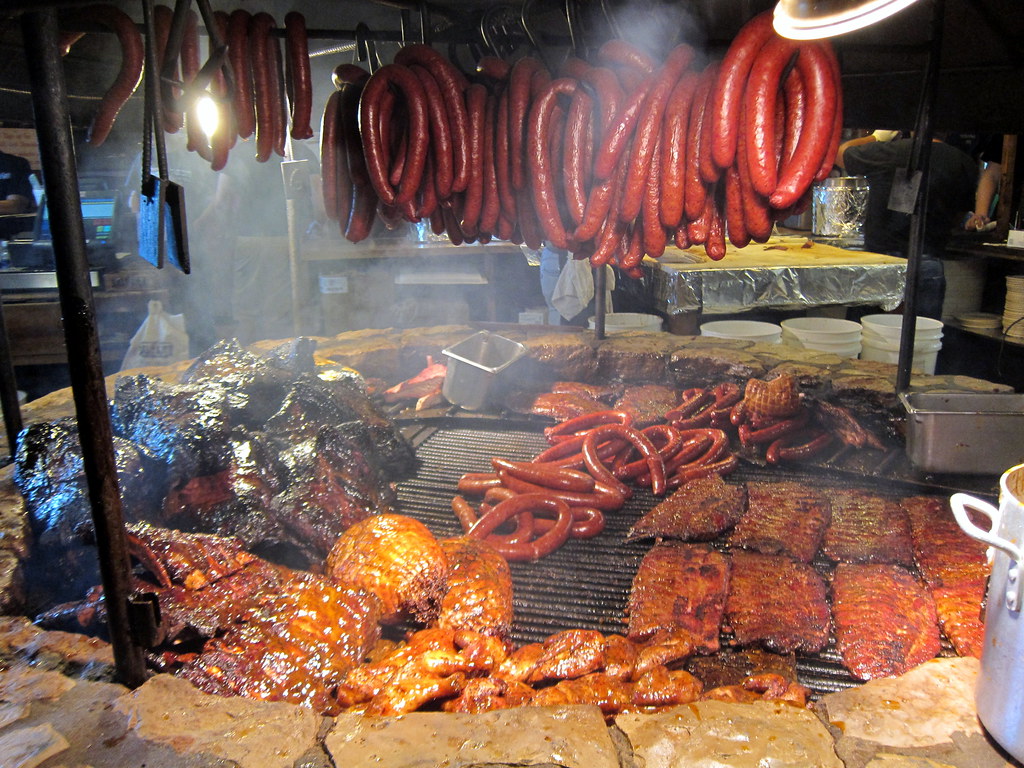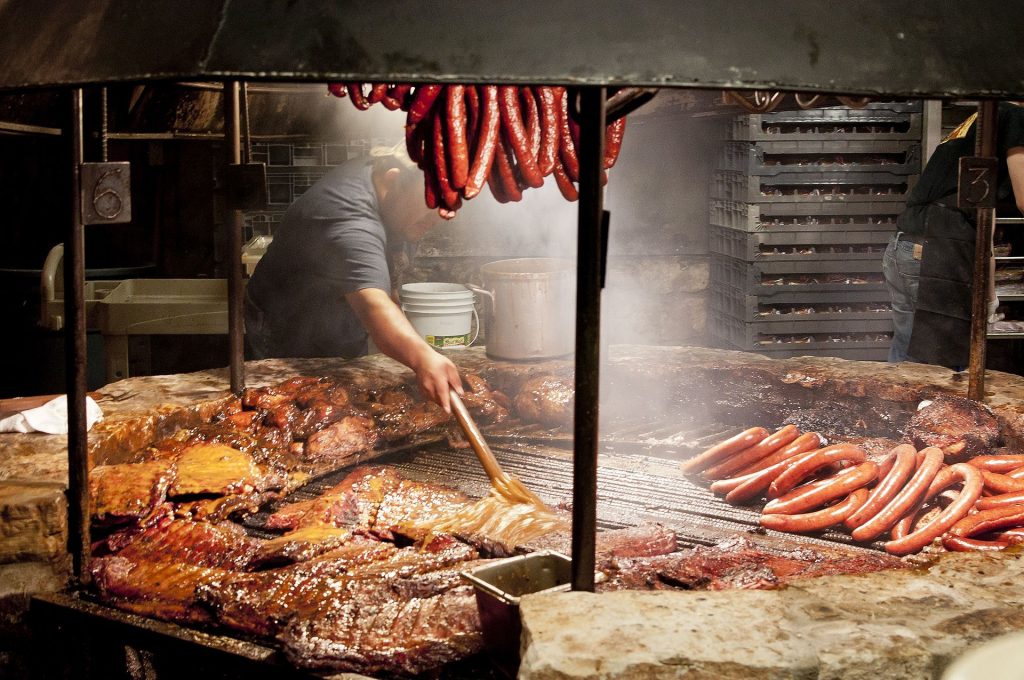Out of the frying pan, and into the flame! When we think of taste, it is usually defined by something memorably appeasing or displeasing to the senses. Well, we can define what we taste with our palate by describing sweet, salty, bitter, etc. But taste is a product of society. “Anthropologist Marvin Harris — maintains that food choices made by the peoples and by individuals are always determined according to a more or less conscious calculation of the resulting advantages and disadvantages.”1 My focus will be on how consumerism has shaped what American’s eat and their struggle to authenticate an American culinary identity. Through the brief history and presentation of the relevance of food as culture, I will digress through reasons as to why food is presented the way it is and the politics that surround the process of getting food from the field to the table.

“Eat More Beef!” Is a slogan I remember growing up seeing on billboards during the 90’s around town promoting the local Chic-fil-a and accompanied with it came groves of trending buffets and “Super-Size” portioning of food. “The food industry uses lobbying, lawsuits, financial contributions, public relations, advertising, partnerships and alliances, philanthropy, threats, and biased information to convince congress, federal agencies, nutrition, and health professionals, and the public that the science relating diet to health is so confusing that they need not to worry about diets.”2 The food industry is dependent on farmers to meet their demands, but the irony is that most farmers in rich countries such as America depend on subsidies. Google defines a subsidy as: a sum of money granted by the government or a public body to assist an industry or business so that the price of a commodity or service may remain low or competitive. This was first introduced during the early 1930’s to help farmers during the Great Depression on the count of millions leaving the farmlands to get jobs in the bigger cities. The issue we’re having today isn’t the farm bill, Agricultural Adjustment Act, that enacts congress to procure a new budget for the subsidies every five years but the fact that most of the subsidies are given to large commercial farmers that already make well above the national average for non-commercialized farmers. The rising need to plant corn for bio-fuels creates a niche in the market. “For stockholders, it is irresponsible—and illegal—for companies to make decisions that will not lead to increased profits.“3 This means that the type of food we’re most likely to afford is that one that guarantees the most return for investors even if it comes at the cost of sacrificing nutritional health.

Why do most Americans struggle to identify with an “authentic” original cuisine? Most of the dishes that developed in America came rooted from mostly Europe, that is up until the Immigration and Naturalization Act of 1965 lifted immigration restrictions from Asia, Latin American, and Africa. These groups brought cultural cuisines that inevitably mixed with American food, but this wasn’t the first time in America that an Asian’s culinary cuisine had been presented. “…culinary essayist and historian John Shu-fan, who pointed to Hong Kong Surgeon, the autobiography of Li Shu-fan, for a firm assertion that chop suey was being served in Toisan restaurants by 1894.”4 But how could a trend started in America have such an impact that the dish made it’s way back to its origin of inception? The problem isn’t innovation; the problem is finding a way to coin a dish as authentic. So why does it still struggle in the authenticity department today? The cycle of authentication relies on the interplay between producers, consumers, and critics who are continuously seeking the authentic; the realness of a cultural product in comparison to similar products. Thus, this relationship can destabilize authenticity so it continuously evolves rather than remaining static.”5 The paradox of trying to be authentic in an innovative society is the bane of progress, but all isn’t lost! This opens to doors to new interpretations about how we look at food.

The proof is in the pudding! After we discover the origins of America’s one true cuisine then will come the painstaking process of replicating it to taste, because after all, taste is inherently cultural. “My own capacity to tolerate pungent foods are perfect examples of the fascinating interplay between genes, habitat, culture, and individual experience.”6 Since each ingredient is distinguishable from one another, how does one go about creating consistency that pays homage to the heritage of a dish while staying true to its ever-varying definition? The answer is simple: keep it fresh. Historically, livestock varied from state to state depending on what type of animals’ settlers brought with them; Texas had beef, the Carolina’s had pork, and Kentucky had mutton. The history surrounding barbecue dates back to the colonial days where the position of barbecue master was traditional given to the older male slave of the plantation. With roots deeply embedded in the craft there is no mistake as to its authenticity in origin. There’s a stigma attached to the smaller barbecue restaurants being considered more “authentic” than their larger franchised counterparts. This stigma evolved from the misconception that the smaller establishments were less profitable on the count of that their ingredients were locally fresh because they lacked the connections that larger businesses have when it comes to obtaining cheaper processed ingredients. These smaller family-owned businesses are able to hold longevity because they reflect the community from which they serve. The slaughter house down the road from which the meat was procured from, the local farm which produced the spices for the family secret ingredient, or the massive amount of wood that’s needed to sustain the hours of operations of these establishments are just some of the ways how all these people are closely interconnected and dependent on one another. Keeping ingredients fresh and local gives integrity to the cuisine that it so rightfully deserves. This tradition of keeping a high regard for the authentication of barbecue creates the ambiance of culture, and in order to preserve it then so must everything that encompasses it including the availability of fresh crucial ingredients.
Understanding how the misrepresentation of food is detrimental to culture helps a person not only understand their own roots but also acknowledges the significance that food has on society as a whole. In a melting pot society, the banality of monotony drives innovators to create new fads and trends to help compensate for the shortcomings by way of quality produced by a capitalist society. This raises the importance of localizing food to create a demand to drive the local economy. The only way to eliminate government spending on crops to utilize bio-fuels and more on real produce is to create a high enough demand to have them accommodate our needs. “Authentic food is determined based on an established set of standards and conventions rooted in traditional practices.”7 Innovations utilizing local foods in a traditional manner creates authenticity, so it’s up to us as a society to uphold these standards to keep the traditions alive as they are a part of our American identity because after all if you’re invited to the barbecue…you’re family.

- Massimo Montanari. Food Is Culture. Arts and Traditions of the Table. (New York: Columbia University Press, 2006),71. ↵
- Marion Nestle. Food Politics : How the Food Industry Influences Nutrition and Health. Vol. Rev. and expanded ed. California Studies in Food and Culture. (Berkeley: University of California Press, 2007), 358. ↵
- Marion Nestle. Food Politics : How the Food Industry Influences Nutrition and Health. Vol. Rev. and expanded ed. California Studies in Food and Culture. (Berkeley: University of California Press, 2007), 362. ↵
- Mendelson, Anne. “The Birth of Chinese American Cuisine.” In Chow Chop Suey: Food and the Chinese American Journey, 99–137. (Columbia University Press, 2016), 105. ↵
- Kaitland M. Byrd. Real Southern Barbecue : Constructing Authenticity in Southern Food Culture. Lanham: Lexington Books, 2019), 13 ↵
- Gary Paul Nabhan. Food, Genes, and Culture : Eating Right for Your Origins. Washington, DC: Island Press, 2013),118. ↵
- Kaitland M. Byrd. Real Southern Barbecue : Constructing Authenticity in Southern Food Culture. (Lanham: Lexington Books, 2019), 26 ↵



8 comments
Enrico Zorzin Onzi
Hello Daniel, I liked the topic of your article, it is interesting. As I am from Brazil, when I arrived in the United States, I got a little surprised about the Americans typical foods. I have never seen so many fast foods in everywhere. I understand that it is cultural, and restaurants have been trying to make the food cheaper and faster, but it has some negative points that must be considered such as the food loses quality, and it is not healthy. When restaurants try to prepare the food as soon as the customer ordered it, they opt to use industrialized spices, dressings, sauces, and so on. That is why, most fast foods have a high level of calories in the food they make.
Kanum Parker
The standard of food has gone down as of lately because there is always how can I make it cheaper so I can sell more and have people by more, this is a problem because what they do to make it cheaper is not really healthy. We need to change this standard of food because it has lots of long term affects on everyone who eats it.
Gabriella Parra
I love how your voice was so distinctive throughout the article. It is amazing how capitalism affects our food in America. I think Taco Bell is a great example of food innovation in our society. I feel like they come out with a mind-boggling creation every few months. It’s definitely not authentic, but it’s what people like and what they can pay for. This kind of reminds me about the ethical clothing consumption discussion. In the same way a lot of people can’t afford quality, ethically made clothing, many people can’t afford authentic food from a restaurant that uses locally sourced, fresh ingredients. They can barely afford fresh, healthy ingredients to use at home.
Carlos Hinojosa
This article explains something I thought I would never question and That’s the idea of authentic food. To me authentic food was anything from a culture like tacos from Mexicans, Gumbo form Louisiana, cheesesteaks from Philly and even syrup from Canada. I never knew it took more than that to classify something as Authentic. A very well-made article and I hope I get to read more. Oh, I also liked your cover image.
Andrea Moreno
This article was incredibly informative on how food relates to culture. In many ways, food can be a person’s first experience with a culture outside of their own. It is also interesting to see how food is linked to tradition as well as a culture’s history. This article was a perfect way to get acquainted with the importance of food in relation to culture.
Makenzie Bell
I enjoyed reading about the different cultures of food, not only did this article make me want to travel and try different foods but I was also able to be informed of the different traditions that go into food. The small intros to the paragraphs really hooked me into wanting to know what was going to be talked about next.
Martha Nava
Very interesting article, I kind of wish it was longer! I find it interesting how the government still subsidies these farmers, and how many nutrition/health companies are paid to say/promote certain things. I also didn’t know that Barbecue dated that far back. I think you are passionate about your topic which really showed through. I also like the little intro to each paragraph that you made. Overall, I think you communicated your message about the traditions and culture of food very well.
Hannah Young
I loved reading this article! Not only did it talk about food but it talked about food in a way of culture and how certain foods or portions can effect our health for the worse. You talked about different traditions or ingredients that might go into food which made me think about how our American cuisine came to be, which you said was a combination of many things. I enjoyed learning about food more and hope to always learn more and explore different ways to cook.